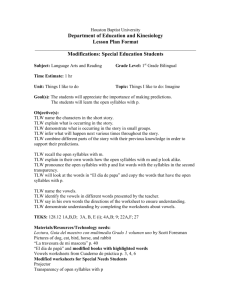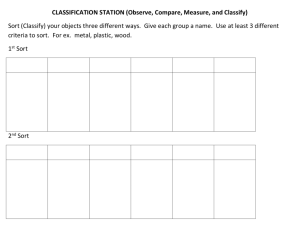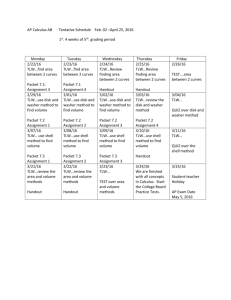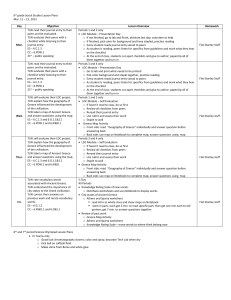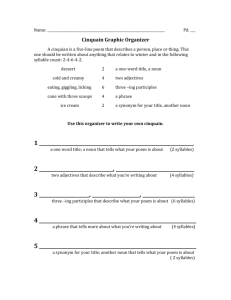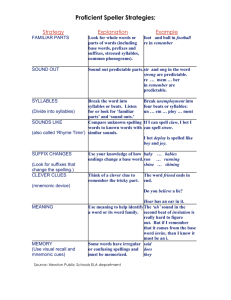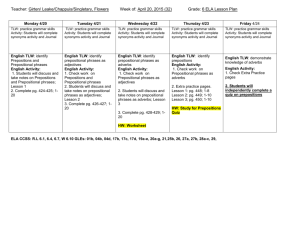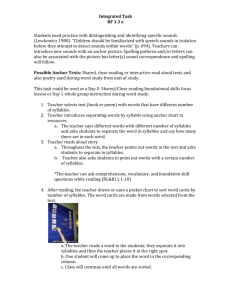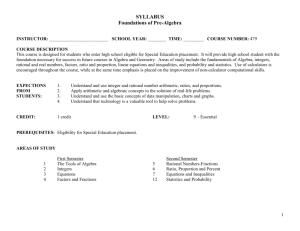Lesson Plans - Houston Baptist University
advertisement
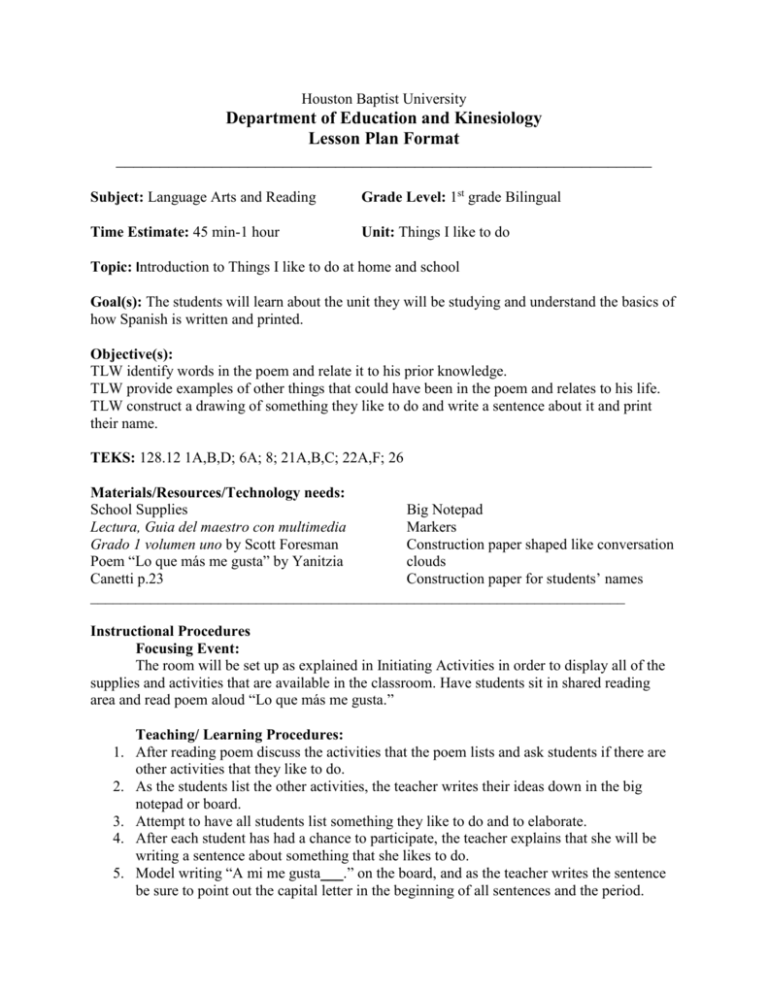
Houston Baptist University Department of Education and Kinesiology Lesson Plan Format _____________________________________________________________ Subject: Language Arts and Reading Grade Level: 1st grade Bilingual Time Estimate: 45 min-1 hour Unit: Things I like to do Topic: Introduction to Things I like to do at home and school Goal(s): The students will learn about the unit they will be studying and understand the basics of how Spanish is written and printed. Objective(s): TLW identify words in the poem and relate it to his prior knowledge. TLW provide examples of other things that could have been in the poem and relates to his life. TLW construct a drawing of something they like to do and write a sentence about it and print their name. TEKS: 128.12 1A,B,D; 6A; 8; 21A,B,C; 22A,F; 26 Materials/Resources/Technology needs: School Supplies Big Notepad Lectura, Guia del maestro con multimedia Markers Grado 1 volumen uno by Scott Foresman Construction paper shaped like conversation Poem “Lo que más me gusta” by Yanitzia clouds Canetti p.23 Construction paper for students’ names _______________________________________________________________________ Instructional Procedures Focusing Event: The room will be set up as explained in Initiating Activities in order to display all of the supplies and activities that are available in the classroom. Have students sit in shared reading area and read poem aloud “Lo que más me gusta.” Teaching/ Learning Procedures: 1. After reading poem discuss the activities that the poem lists and ask students if there are other activities that they like to do. 2. As the students list the other activities, the teacher writes their ideas down in the big notepad or board. 3. Attempt to have all students list something they like to do and to elaborate. 4. After each student has had a chance to participate, the teacher explains that she will be writing a sentence about something that she likes to do. 5. Model writing “A mi me gusta___.” on the board, and as the teacher writes the sentence be sure to point out the capital letter in the beginning of all sentences and the period. 6. The teacher then takes a construction paper shaped as a cloud, copies the sentence on the board, and adds an activity: “A mi me gusta leer.” 7. The teacher can draw a picture of her reading a book. 8. After writing the sentence, tell students that they too will have a chance to write and draw what they like to do. 9. Show them the cloud construction paper and explain to them that they will write a sentence like the one modeled but that they will write what they like to do. Point out the list that was made as a class for reference on spelling. 10. Give out cloud to each student and ask if there are any questions before sending students to their desks. 11. Send students to their desks to work on writing and drawing. There should be materials ready for the students to use in their desks. 12. The teacher walks around, monitors, and answers any questions. 13. Explain to students that once they finish they must raise their hand so that you can give them another paper. 14. This second paper will be used to write their name. The students will have their nametags taped to their desks to use for reference if they need help writing it. 15. As the students raise their hands, give them the new page and point out the one already taped on the bulletin board that says “Ms. Silva.” 16. As students work on the second paper, tell them that as they finish they must raise their hand once again. 17. When the student finishes, he/she will be asked to take both papers and walk towards the bulletin board to put it up with the help of the teacher. Formative Check(ongoing or specific): 1. The teacher will walk around and monitor as they work on the clouds. 2. The students will share what they wrote about at the end of the lesson. Reteach (alternative used as needed): 1. The teacher will model writing another sentence and will chose another activity from the list. She will demonstrate and think-aloud how she is choosing to copy one of the activities already in the list. Closure: 1. After all students have finished and all of their clouds and names are put on the bulletin board, have all students sit facing the bulletin board. The teacher will begin with her cloud, read the sentence, and explain her drawing. Each student will have an opportunity to share the activity that each wrote and drew about with the rest of the class. 2. Tell students that they will be doing some, yet not all of the activities that are listed on the bulletin board throughout the unit and the year. Assessment/Summative Evaluation: The cloud that each student wrote on and drew will be the grade for the day. At the end, the teacher will model writing another sentence but this time do not capitalize first letter and do not include period. Move on without pointing out mistakes to see if the students notice, and if they do not notice the teacher will point it out. Modifications/Notes: For those students who are identified as gifted and talented, provide them with an extra cloud and have them write another sentence. For those students with disabilities, provide a cloud that already has the first words “A mi me gusta” written on them. The teacher will write three of the activities listed by the class in a separate paper and have the student copy one of the three after discussing which of the three is his favorite. Houston Baptist University Department of Education and Kinesiology Lesson Plan Format _____________________________________________________________ Subject: Language Arts and Reading Grade Level: 1st Grade Bilingual Time Estimate: 1 hr Unit: Things I like to do Topic: Things I like to do: Imagine Goal(s): The students will appreciate the importance of making predictions. The students will learn the open syllables with p. Objective(s): TLW name the characters in the short story. TLW explain what is occurring in the story. TLW demonstrate what is occurring in the story in small groups. TLW infer what will happen next various times throughout the story. TLW combine different parts of the story with their previous knowledge in order to support their predictions. TLW recall the open syllables with m. TLW explain in their own words how the open syllables with m and p look alike. TLW pronounce the open syllables with p and list words with the syllables in the second transparency. TLW will look at the words in “El dia de papa” and copy the words that have the open syllables with p. TLW name the vowels. TLW identify the vowels in different words presented by the teacher. TLW say in his own words the directions of the worksheet to ensure understanding. TLW demonstrate understanding by completing the worksheets about vowels. TEKS: 128.12 1A,B,D; 3A, B, E (i); 4A,B; 9; 22A,F; 27 Materials/Resources/Technology needs: Lectura, Guia del maestro con multimedia Grado 1 volumen uno by Scott Foresman Pictures of dog, cat, bird, horse, and rabbit “La travesura de mi mascota” p. 40 “El dia de papá” Vowels worksheets from Cuaderno de práctica p. 3, 4, 6 Projector Transparency of open syllables with p _______________________________________________________________________ Instructional Procedures Focusing Event: Display pictures of animals that could be pets: dog, cat, bird, horse, and rabbit. Ask students if they have any pets as the ones displayed on the board. As some will probably not have one, tell them that today they are going to “imagine” or pretend that they have one for the next part of the lesson. Teaching/ Learning Procedures: Reading: 1. The teacher reads the title of the short story: “La travesura de mi mascota” and ask students what they think or imagine will be the mischief of the pet. 2. Then read the story, but make the necessary pauses as marked in the text to allow students to guess what will happen next in the story. 3. The students will be asked to identify the characters. 4. Have students in each group to demonstrate what the pet is doing and how the owner of the pet would react. 5. Tell students that as they guess what will happen next in the story is called predicting. As the students say their predictions ask them “Why do you think__ ?” so that they can justify their ideas. Phonics: 6. The teacher will ask students to recall the open syllables with m by showing them the transparency of open syllables with m (but cover the top of the transparency so they are not able to see the syllables). 7. The teacher will write the open syllables with m (ma, me, mi, mo, mu) on the board, and right below them write the open syllables with p (pa, pe, pi, po, pu). Ask students for the similarities between the two. 8. Present to students the transparency for open syllables with p and ask students to name the pictures. Demonstrate to students how they can insert the syllable from the top line into the word to complete the word. 9. Ask students for other words that they can think of or see around the room that have the open syllables with p. 10. As the students name the words ask them to categorize under what column it would go under. 11. Ask students to take out their phonics book, “El dia de papá,” and look through it to copy any words with the syllables in their notebook. 12. After giving them about 4-5 minutes to do this, ask students to share the words. 13. Write all of the words on the board, and then ask students to categorize them as the teacher writes them on the transparency. Phonemic Awareness: 14. Ask students to name the vowels and write them on the board. 15. The teacher writes words on the board and asks students to identify the vowels in the words. The words can include: mochila, lápiz, borrador, pizarrón, maestro, hola, mamá, papá, libro. 16. Show students the worksheets that they will work on and after having a student helper pass out worksheets, ask students to explain the directions with their seating partner. 17. After they have discussed, the teacher does the first question together with the students. 18. As the students work on the worksheets, the teacher walks and monitors. Pass out to the students the take home worksheet for homework. Formative Check(ongoing or specific): 1. As the students give ideas of their prediction, question them and ask them to elaborate and justify their ideas. 2. As the students work on the worksheets, the teacher monitors their progress. Reteach (alternative used as needed): 1. When teaching predictions have a visual representation of the story and have possible events that the students can choose from to help them in predicting. 2. If there are problems with learning the open syllables with p, provide more examples. 3. If there are problems with learning and identifying vowels, provide more words as examples. Closure: 1. Ask students why imagining or predicting is important. Assessment/Summative Evaluation: The worksheets will be taken up to check their understanding of vowels. Modifications/Notes: For those students who are identified as gifted and talented, provide them with extra worksheets to work on open syllables with p. For those students with disabilities, provide them an easier worksheet and have a tutoring session to review open syllables with m, p, and vowels. Houston Baptist University Department of Education and Kinesiology Lesson Plan Format _____________________________________________________________ Grade Level: 1st grade Bilingual Subject: Language Arts and Reading Time Estimate: 45 min Unit: Things I like to do Topic: Things I like to do: Share and Listen Goal(s): The students will learn about main ideas. The students will understand how to work together to present their work of examining and describing an object. Objective(s): TLW identify what “main” and “idea” mean. TLW in their own words tell what “main idea” means. TLW demonstrate understanding of what main idea means after listening to short story. TLW apply their understanding of main idea with Mariza en la escuela in identifying it and helping teacher write sentence. TLW name the colors learned. TLW in his own words identify the object (a green apple) and its color. TLW apply the modeled exercise as they work with a partner to identify an object, what it is used for, and its color. TLW each write a sentence (with the help of the teacher’s example) regarding the object and its color. TLW in pairs demonstrate their understanding by presenting their object to the class –one can name the object and the other can name the color. TEKS: 128.12 1A,B,D; 20A(iii); 21; 22A,C,F; 27 Materials/Resources/Technology needs: Mariza en la escuela Board Green Apple Different objects for activity: erasers, cups, marbles, etc Paper Sentence Strip for each group _______________________________________________________________________ Instructional Procedures Focusing Event: Write the words “main” and “idea” on the board and ask students what the two words mean. Then ask students what “main idea” would mean. Tell them that they will be preparing to identify the main idea of the book they read Mariza en la escuela. Teaching/ Learning Procedures: Reading: 1. The teacher will ask students to recall the events in Mariza en la escuela. The teacher will write what the students say on the board. 2. After having all of the different ideas on the board, ask students what would be the main idea- the thing that sums up everything that happened in the book. If students name a detail that has been listed and is on the board, point it out and explain that is only a detail of the total story. 3. The main idea would be: At first Mariza did not want to go to school, but after doing different fun activities, she did not want to leave. 4. After the students have come up with the main idea with the teacher’s guidance, the teacher will ask students to help her write a sentence regarding the main idea. As the teacher writes the sentence, ask students about capitalization, periods, and the following words in the sentence. Language Arts: 5. Ask students to recall the names of the different colors. Ask students to raise their hands and to come up to the board and write the name of a color in the board. 6. Then present a closed brown bag to students and ask them what they think is inside the bag (a green apple). 7. Pass the bag around and tell students that they can touch the outside of the bag and continue making guesses. 8. After students have come up with fruit or apple, take out the apple and ask students to identify the object and its color in a sentence. “Es una manzana verde.” 9. Explain to students that now you are going to pass out different objects to each pair of students. 10. In their group, they are going to discuss what the object is and how it can be used. 11. The students must identify the color of the object and must write a sentence with the name of the color of the object in a sentence strip. 12. The teacher would model writing a sentence for the green apple: El color de mi cosa es verde.” 13. As the students work, the teacher will walk around and monitor the students. 14. The students will then come up the front of the class. One student will explain what is their object and what it is used for and the other student will say what they have written together regarding the object’s color. Formative Check(ongoing or specific): 1. As the students work in pairs to identify the object, the teacher will walk around to ensure that they are working together well and accomplishing their goals. Reteach (alternative used as needed): 1. Understanding main idea might be difficult for students, and for that reason, another shorter story could be read to the students to identify the main idea. There will be further practice in identifying main idea in texts. Closure: 1. Give a summary sentence regarding main idea and ask students why knowing the main idea is useful- could ask what if I have not read the book, would the main idea help me know what you read? Assessment/Summative Evaluation: The sentence strips and objects of the students will be displayed in the classroom and this will serve as a grade for the lesson as they practiced writing complete sentences, identifying colors, and working together. Modifications/Notes: For those students who are identified as gifted and talented, provide them with extra paper to write more about the object they observed. For those students with disabilities, allow them to have the object and orally explain their object without writing the sentence. Allow them to write the sentence with the teacher’s help.
